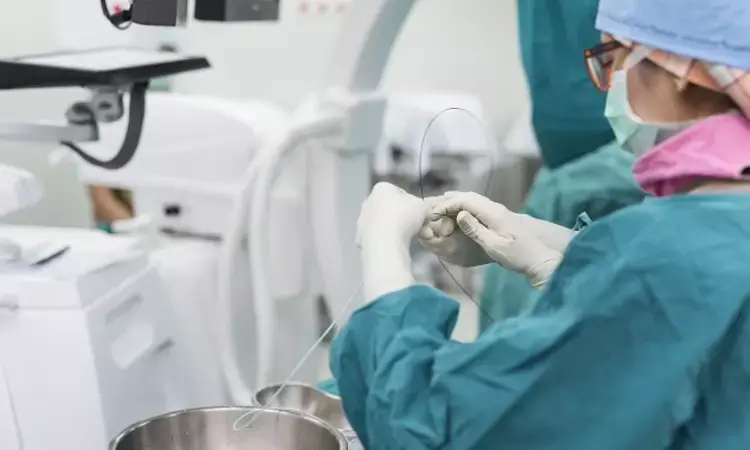- Home
- Medical news & Guidelines
- Anesthesiology
- Cardiology and CTVS
- Critical Care
- Dentistry
- Dermatology
- Diabetes and Endocrinology
- ENT
- Gastroenterology
- Medicine
- Nephrology
- Neurology
- Obstretics-Gynaecology
- Oncology
- Ophthalmology
- Orthopaedics
- Pediatrics-Neonatology
- Psychiatry
- Pulmonology
- Radiology
- Surgery
- Urology
- Laboratory Medicine
- Diet
- Nursing
- Paramedical
- Physiotherapy
- Health news
- Fact Check
- Bone Health Fact Check
- Brain Health Fact Check
- Cancer Related Fact Check
- Child Care Fact Check
- Dental and oral health fact check
- Diabetes and metabolic health fact check
- Diet and Nutrition Fact Check
- Eye and ENT Care Fact Check
- Fitness fact check
- Gut health fact check
- Heart health fact check
- Kidney health fact check
- Medical education fact check
- Men's health fact check
- Respiratory fact check
- Skin and hair care fact check
- Vaccine and Immunization fact check
- Women's health fact check
- AYUSH
- State News
- Andaman and Nicobar Islands
- Andhra Pradesh
- Arunachal Pradesh
- Assam
- Bihar
- Chandigarh
- Chattisgarh
- Dadra and Nagar Haveli
- Daman and Diu
- Delhi
- Goa
- Gujarat
- Haryana
- Himachal Pradesh
- Jammu & Kashmir
- Jharkhand
- Karnataka
- Kerala
- Ladakh
- Lakshadweep
- Madhya Pradesh
- Maharashtra
- Manipur
- Meghalaya
- Mizoram
- Nagaland
- Odisha
- Puducherry
- Punjab
- Rajasthan
- Sikkim
- Tamil Nadu
- Telangana
- Tripura
- Uttar Pradesh
- Uttrakhand
- West Bengal
- Medical Education
- Industry
Novel X-ray shield cuts radiation exposure to the operator by greater than 80 per cent: Study

Norway: Radiation shielding is necessary during cardiac catheterization, but there is a need to improve ease of use and efficacy. A recent study published in Circulation: Cardiovascular Interventions sought to evaluate the shielding effect and user feedback for a novel flexible multiconfiguration x-ray shield (FMX).
The researchers found that the reusable and flexible radiation shield that lays across the patient like a blanket can reduce tradition to operators in that cath lab by as much as 84% compared with routine protection strategies.
"The reductions in radiation dose to the operators were similar for diagnostic angiography and PCI and similar in female and male operators," reported Cedric Davidsen, Haukeland University Hospital, Bergen, Norway, and colleagues. According to them, the novel device they developed and tested offered protection against scatter that may be missed by table- and ceiling-mounted shields.
"The FMX was designed to maintain ease of use and protection across a variety of patients, procedure types, and access sites," the study stated. "The system can be fully and immediately removed or repositioned in seconds according to clinical need.”
The 0.5-mm Pb equivalent FMX can be configured selectively to accommodate for variations in access site, patient morphology, and type of procedure with maintained visualization, shielding, and vascular access. Relative operator dose (operator dose indexed for given dose) was measured during 103 consecutive procedures randomized in the proportion of 1:1 to the current routine setup or FMX+routine, to evaluate the efficacy. User feedback was collected on relevance, function, and likelihood of adoption into clinical practice.
The study revealed the following findings:
- The median relative operator dose was 3.63 μSv/µGy·m2×10-3 with routine setup and 0.57 μSv/µGy·m2×10-3 with FMX+routine, which amounts to an 84.4% reduction.
- For 500 procedures/year, this corresponds to an estimated yearly dose reduction from 3.6 to 0.7 mSv.
- User feedback regarding size, ease of use, functionality, likelihood to use, critical issues, draping, shielding, vascular access, procedure time, patient discomfort, and risk was 99% positive.
- No critical issues were identified. There was no significant difference in patient radiation exposure.
"The FMX considerably reduced radiation exposure and represents an attractive and effective solution for radiation protection that can easily be implemented in existing workflow," the researchers wrote.
"FMX has the potential for general use with maintained visualization, shielding, and vascular access in routine cardiac catheterization," they concluded.
Reference:
Davidsen C, Ytre-Hauge K, Samnøy AT, Vikenes K, Lancellotti P, Tuseth V. Efficacy and User Experience of a Novel X-Ray Shield on Operator Radiation Exposure During Cardiac Catheterization: A Randomized Controlled Trial. Circ Cardiovasc Interv. 2023 Nov 13:e013199. doi: 10.1161/CIRCINTERVENTIONS.123.013199. Epub ahead of print. PMID: 37955163.
Dr Kamal Kant Kohli-MBBS, DTCD- a chest specialist with more than 30 years of practice and a flair for writing clinical articles, Dr Kamal Kant Kohli joined Medical Dialogues as a Chief Editor of Medical News. Besides writing articles, as an editor, he proofreads and verifies all the medical content published on Medical Dialogues including those coming from journals, studies,medical conferences,guidelines etc. Email: drkohli@medicaldialogues.in. Contact no. 011-43720751


